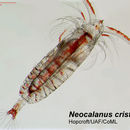en
names in breadcrumbs


The 5th stage copepodites of this large copepod are glass-clear, with bright red pigment, scattered around the head, thorax and antennules. The coloration of the A1 gets paler near the middle of the antennules and becomes bright again toward the distal end. The posterior corners of the last thoracic segment carry 2 asymmetrical pigment spots. All armature of the A1, caudal chaetae and the exopodites of the swimming legs are also brightly colored. Specimens from great depths (about 2000 m in the Sea of Japan) are even more brightly colored, sometimes completely red. Males are not pigmented and significantly less transparent than C5 stages.
Different from all other Calanus and Neocalanus species by the presence of a crest on the forehead, which is largest in the P5 stage (smaller in females, and even smaller in males).
Endemic of the North Pacific from 40-45d.n.. Massive presence in the Sea of Japan, Sea of Okhotsk, and Bering Sea. Can be carried into the Chukchi Sea, some individual – into the Arctic Basin.
Meso- to bathypelagic oceanic species, with seasonal ontogenetic migrations of large amplitudes, well pronounced diurnal vertical migrations.
Annual cycle. The female does not feed, so all reproduction occurs based on lipids accumulated over the prior summer. Although they cannot exploit current production, it allows them to spawn much earlier than other co-occurring species. N. cristatus diapause as C5, then need to molt and spawn, reaching the surface later. Nauplii do not feed.
Female:
Body shape elongate-oval from dorsal view. The head carries a distinctive crest, visible both from dorsal and side view, best pronounced in the C5 stage. The cephalosome is separate from the thorax, the 5th thoracic segment is separate from the 4th. The posterior corners of the last thoracic segment are smoothly rounded, without projections of points. The boundary between the cephalosome and the 1st thoracic segment on dorsal side carries a small, but well pronounced knob. From dorsal view it is almost triangular in shape, but with a rounded tip, which is directed toward the back. The abdomen is relatively short and stout, about 4.6 times shorter than the cephalothorax.
The 2 penultimate segments on A1 carry 2 long and densely plumose chaetae.
Feeding appendages slightly reduced.
The inner edge of the coxopodite of P5 is smooth, not serrated, in P3-P4 the coxopodite carries a row of thin setules. The apical spines of P3-P4 are straight, in P5 – slightly curved. The outer edges of P3-P5 with a thin clear “blade”, which is smooth, not serrated. All branches of all legs are 3-segmented. Armature of P1 and P5 typical for the family, the 3rd segment of the endopodite of P5 with 3 chaetae on both sides.
Male:
The crest is much smaller than in females and the C5 stage. It is visible only on the highest point of the body, from dorsal view it is distinguishable only as a small, slightly rounded projection. The cephalothorax with almost parallel edges (from dorsal view), thus, the width of the head and thorax is almost equal. The line separating 1st thoracic segment carries a knob as in females.
Abdomen short, 3.5 times shorter than the cephalothorax. The longest segment is the 2nd, it is almost as long as wide; the shortest is the 4th segment. Caudal rami short and relatively wide, only slightly longer than wide.
A1 longer than the body by 3-4 distal segments, strongly flattened dorsoventrally. The armature of the penultimate segments is very weak.
Mouthparts reduced to a great extend.
P1-P4 same as in female. The apical spines of P2-P4 massive, more strongly curved than in females.
The inner edge of the coxopodite of P5 is s smooth, not serrated. The left exopodite is longer than the right and the length of its segments are modified. Protopodites are also asymmetrical. Endopodites are similar on both legs, they reach the middle of the 3rd segment of the exopodite of each corresponding leg.
Female: 7,60-10,40 mm; Male: 6,70-9,60 mm
Selective filter feeder. Females and males do not feed at adulthood.